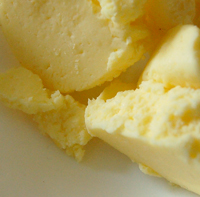We all begin as butter people; nobody erupts from the womb ready to move from mother’s milk to margarine. Kids happily spread their school-lunch rolls with individual pats of butter, top their pancakes with generous globs of the stuff, and will even take bites of butter sticks when a caregiver isn’t looking. But slowly, margarine creeps in. Maybe we eat margarine because our parents do; others among us switch when we’re old enough to start paying attention to our waistlines or hearts. After all, the American Heart Association and the Mayo Clinic both recommend using margarine. So eventually, we stand in the dairy aisle, look at our options, and put the margarine in our carts.
If you’re interested in food enough to be reading a food column, you shouldn’t need me to tell you that the sensible way to approach butter — or any other high-calorie, high-fat food — is through moderation and portion control, and not through a scientifically engineered substitute. And it’s not as if margarine was created to be better than butter: although one might think margarine was invented as a healthy alternative, it actually was just meant to be an inexpensive substitute for butter when milk was in short supply. This also means that margarine was invented earlier than you’d expect, all the way back in 1870.
Butter, however, has been around for thousands of years. The ancient Egyptians used it, and there are several references to it in the Bible (“And it shall come to pass, for the abundance of milk that they shall give he shall eat butter: for butter and honey shall every one eat that is left in the land” — Isaiah 7:22). The animals we use for milk today might have changed since biblical times, but the process is still the same: Cream is agitated until it separates into butter and buttermilk. The butter is then put through a water wash to clear out any leftover buttermilk (which can make the butter spoil), and, depending on what it will be used for, the butter is possibly mixed with salt to preserve it. That’s it. One ingredient goes in, butter comes out. While margarine recipes, on the other hand, do vary from company to company, they all contain some combination of emulsified oils and a liquid such as milk or water. One margarine I came across was made partially of fish oil.
The other thing about butter is that it does a lot that margarine simply can’t do. Think of it like having two kids: Margarine is really pretty but kind of a dolt, and butter is less attractive but has all of the talent and personality. Whipping butter until it’s airy gives cakes and cookies a texture that margarine can’t touch, and I cringe at the idea of someone trying to make a “sage and brown margarine” sauce. Plus butter can go all gourmet, with local farms creating rich, beautiful variations from fresh cream. There’s an Amish butter sold at a farmer’s market near me that is so gorgeously sweet on its own, I barely need to add sugar when I use it to bake.
But let’s get back to that “sage and brown margarine” sauce for a moment, which demonstrates a point: eating margarine when you want butter is just stupid. When you choose margarine, you’re choosing to resign yourself to a mediocre version of what you really want. You’re hoping that a reduced-calorie faux-food will fix your health problems instead of just letting yourself have what you really want and figuring out how to mitigate the consequences in a healthy way.
We begin as butter people, and even if you’re under layers of margarine right now, I’ll bet you still have a butter person inside. • 5 November 2009
| Butter |
 My first introduction to making butter came in elementary school; every Thanksgiving my class would don paper hats and sit in a circle, shaking cream in a jar until it turned into butter. For my most recent butter-making foray, I decided to eschew the jar, and I also avoided using a food processor as some recipes recommend. Instead I decided to go with the Ziploc bag method, which I swore I read about once, but I can’t find where I read it. In retrospect, I might’ve actually read a recipe for Ziploc bag ice cream and in my memory, filed it under butter. Either way, I made the butter by putting cream in Ziploc bags and jostling it with my feet while I worked at my computer. Yes, it sounds silly, but it worked really well. My first introduction to making butter came in elementary school; every Thanksgiving my class would don paper hats and sit in a circle, shaking cream in a jar until it turned into butter. For my most recent butter-making foray, I decided to eschew the jar, and I also avoided using a food processor as some recipes recommend. Instead I decided to go with the Ziploc bag method, which I swore I read about once, but I can’t find where I read it. In retrospect, I might’ve actually read a recipe for Ziploc bag ice cream and in my memory, filed it under butter. Either way, I made the butter by putting cream in Ziploc bags and jostling it with my feet while I worked at my computer. Yes, it sounds silly, but it worked really well.
1 cup heavy cream Add the cup of cream to a sandwich-sized Ziploc bag. Close the bag, and put it seam-down in another bag. Do this with three more bags (generally the bags don’t leak, but it’s best to be safe). Agitate the bag for approximately half an hour. You can do this shaking it by hand, but I prefer to keep it at my feet while working at my desk (don’t use shoes!). You’ll be able to feel the cream thicken and finally separate into butter and buttermilk. Drain the buttermilk and scrape the butter into a bowl of cold water (at this point your hands will get ultra-buttery, so either work with disposable gloves or have a towel handy). Wash the butter in the water until the water is clear. If you want to add a sprinkling of salt for preservation or a flavor like chopped chives or honey, mix that in now. Then wrap the butter in wax paper or put it in a container (I store mine in ramekins with parchment paper on top) and put it in the fridge to set. |




